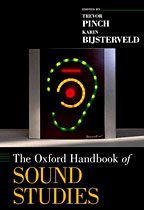Sound effects: Book examines impact of sound on culture

In "The Oxford Handbook of Sound Studies" (Oxford University Press), co-editor Trevor Pinch, professor of sociology and of science and technology studies, takes a look at how sound is experienced in machine shops, design studios, private homes and dance clubs. The book covers everything from the use of bird sounds from the Cornell Lab or Ornithology to early Pixar movies and how Robert Moog, Ph.D. '64, inventor of a music synthesizer, was used in advertising.
Contributors to the book, edited by Pinch and Karin Bijsterveld, professor of science, technology and modern culture at Maastricht University in the Netherlands, examine sounds in industrial, scientific and clinical settings across historical periods and national and cultural contexts. Topics include industrial noise in Germany since the 1920s; automobile sounds; scientific field recording in ornithology; underwater music; scientific musical instruments such as the tuning fork and metronome; sounds used in digital games and animation; and iPod culture.
Rather than trying to understand science visually through slides, graphs and telescopes, the book illustrates how listening has contributed to scientific practice. Contributing authors argue that sounds and music, embedded in the fabric of everyday life, art, commerce and politics, affect our perception of the world. Case studies demonstrate how sounds give rise to new forms of listening practices, and the book discusses noise pollution, hearing loss and the "end" of the amateur musician that stems from new sound- and music-related technologies, analog and digital.
Media Contact
Get Cornell news delivered right to your inbox.
Subscribe